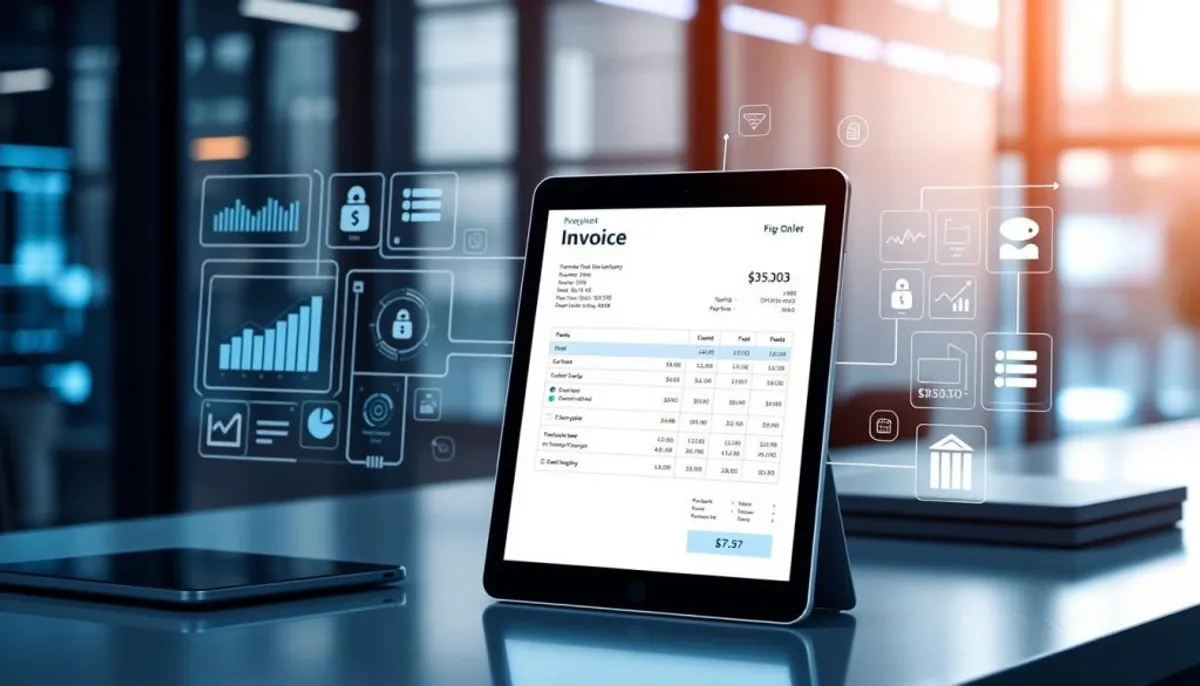Managing accounts receivable is a critical function for any business, serving as the lifeblood that sustains cash flow and operational continuity. For numerous enterprises, notably small businesses, this task proves daunting. A staggering 39% of invoices in the United States are settled after their due date, underscoring the urgent need for adept accounts receivable services.
Cash flow optimization transcends mere jargon; it is an imperative for business survival. The Small Business Administration underscores the significance of maintaining consistent cash flow for business longevity. Without effective revenue management, companies face a 82% failure rate, a stark consequence of poor cash flow management.

Outsourcing accounts receivable services can revolutionize a business’s financial landscape. It facilitates enhanced cash flow, streamlined operations, and access to specialized expertise. This approach is also more economical than maintaining an in-house team. By engaging professional services, businesses can mitigate the risk of bad debts and bolster their financial resilience.
Effective accounts receivable management transcends mere payment collection. It encompasses strategies such as prompt invoicing, consistent follow-ups, transparent credit policies, and the utilization of automated systems. These methodologies not only refine financial processes but also cultivate robust customer relationships.
Key Takeaways
- Nearly 39% of U.S. invoices are paid late, impacting cash flow
- Outsourcing AR services improves financial stability and reduces costs
- Efficient AR management is crucial for business survival
- Clear communication and automation enhance customer relationships
- Professional AR services provide expert support and streamlined operations
Understanding Modern Accounts Receivable Management
Accounts receivable management is a critical component of credit management, directly influencing a company’s financial health. It encompasses the tracking of funds owed by clients, facilitated through billing solutions and payment processing. The effectiveness of AR management is paramount for optimizing cash flow and ensuring financial stability.
Definition and Core Components
AR pertains to the monies owed by clients for goods or services rendered on credit. Its core elements include invoicing, payment tracking, and client communication. Contemporary AR systems often integrate with sales and finance departments, aiming to streamline operations.
Role in Business Financial Health
Proper AR management is indispensable for business expansion. It aids in minimizing payment delays and mitigating bad debt risks. Companies strive to maintain a Days Sales Outstanding (DSO) below 30 days and a high Collection Effectiveness Index (CEI) to ensure financial stability.
Impact on Cash Flow Management
Efficient AR practices are instrumental in enhancing cash flow optimization. By adopting automated billing solutions, businesses can significantly reduce time spent on cash collection, potentially by up to 80%. Such automation facilitates the collection of 99% of payments, expediting payment cycles and boosting overall financial performance.
| Metric | Target | Impact |
|---|---|---|
| Days Sales Outstanding (DSO) | Below 30 days | Faster revenue collection |
| Collection Effectiveness Index (CEI) | Close to 100% | Improved collection success |
| AR Automation Market Growth | 13.3% by 2030 | Increased efficiency in AR management |
By concentrating on these pivotal aspects of accounts receivable management, businesses can refine their financial processes and propel growth.
Benefits of Professional Accounts Receivable Services
Professional accounts receivable services bring numerous advantages to businesses. Outsourcing collections streamlines revenue cycle management and enhances cash flow. This frees up staff to concentrate on core activities, while experts manage the intricate tasks.
One significant benefit is the reduction in overhead costs. By outsourcing, companies avoid the expense of hiring and training in-house staff for accounts receivable duties. This results in substantial savings on labor and software costs. Professional firms leverage advanced tools and technology, obviating the need for businesses to invest in expensive systems.
Another key advantage is the acceleration of invoice processing and the improvement of cash flow. Dedicated teams proactively pursue overdue accounts, boosting the chances of timely payments. This efficiency can lead to a decrease in Days Sales Outstanding (DSO), positively affecting a company’s financial standing.
Professional services also make accounts receivable financing more accessible. These providers bring industry-specific expertise and offer flexible payment options to customers. Such an approach not only boosts customer satisfaction but also encourages prompt payments.
- Reduced administrative burden
- Improved accuracy and error reduction
- Enhanced customer interactions
- Access to specialized knowledge
While the benefits are numerous, choosing a reputable outsourcing firm with a proven track record in accounts receivable management is crucial. Establishing clear service level agreements and continuously monitoring performance ensures a successful partnership. This maintains efficiency in the outsourcing process.
Key Features of ti3 Platform for Payment Management
The ti3 platform is a game-changer for invoice processing and delinquent account recovery. It streamlines payment management, offering features that enhance efficiency and foster positive client relationships.
Automated Payment Reminders
Ti3’s automated system sends weekly SMS and email reminders to debtors. This proactive approach engages businesses with up to 1,000 overdue accounts at once. Automating reminders saves time and boosts the chance of timely payments.
Escalation Management System
The platform provides flexible options for creditors to handle escalating situations. Options include setting up payment plans, offering discounts, and various settlement choices. This system enables a personalized approach to each debtor, enhancing the likelihood of successful account resolution.
Client Relationship Preservation
Ti3 differs from traditional debt collectors by prioritizing positive relationships between creditors and debtors. It allows debtors to settle accounts, create payment plans, and negotiate directly with creditors through user-friendly customer payment portals. This approach can expedite settlements, with online payment options potentially doubling the speed of invoice resolution.
Ti3’s cost-effective pricing model – 99 cents per invoice or a $49 monthly subscription – appeals to businesses of all sizes. Its focus on automation, flexibility, and relationship preservation offers a modern solution to age-old accounts receivable challenges.
Electronic Billing and Online Payment Solutions
Modern enterprises are adopting digital solutions to streamline their financial operations. Electronic billing and online payment systems are transforming invoice processing and enhancing cash flow optimization.
Digital Invoice Processing
Digital invoice processing revolutionizes traditional billing methods. It enables businesses to generate, dispatch, and monitor invoices electronically. This approach diminishes paper waste, accelerates delivery, and minimizes billing cycle errors.

Payment Integration Systems
Customer payment portals are crucial for smooth transactions. These platforms integrate with existing accounting software, allowing clients to view and settle bills online. Research indicates a 59% rise in e-payment adoption with such implementations.
Automated Record Keeping
Automated record keeping is a transformative element for accounts receivable. It tracks payments, updates account balances, and generates reports automatically. This results in a 39% drop in billing-related calls and saves an average of 15 hours weekly on reconciliations.
| Feature | Benefit | Impact |
|---|---|---|
| E-Payment Adoption | Increased Online Payments | 59% Average Increase |
| Paperless Enrollment | Reduced Paper Usage | 104% Average Increase |
| Automated Reconciliation | Time Saved Weekly | 15 Hours on Average |
By integrating these electronic solutions, businesses can notably enhance their invoice processing efficiency. They can also boost customer satisfaction through user-friendly payment portals and achieve superior cash flow optimization.
Essential Performance Metrics and KPIs
Monitoring key performance indicators (KPIs) is vital for the success of accounts receivable services and revenue cycle management. These metrics offer crucial insights into optimizing cash flow and assessing overall financial health.
The Days Sales Outstanding (DSO) is a fundamental metric. It gauges the average time to collect payment post-sale. For example, Inconspicuous Inc. reported a DSO of 45.2 days in February, highlighting their collection efficiency.
The Accounts Receivable Turnover Ratio (ART) is another critical indicator. With an ART of 11.2, Inconspicuous Inc. effectively converted its receivables into cash about 11.2 times annually. This metric showcases the company’s ability to swiftly collect payments from customers.
| Metric | Value | Interpretation |
|---|---|---|
| Collections Effectiveness Index (CEI) | 58.8% | Efficiency in collecting payments over a specific period |
| Average Days Delinquent (ADD) | 8.1 days | Average time customers take beyond the due date to settle invoices |
| Bad Debt-to-Sales Ratio | 13.9% | Indicates effective credit and collection management |
The Right Party Contracted (RPC) Rate is another significant KPI. Inconspicuous Inc. achieved an impressive 87.5% RPC rate, demonstrating the success of their payment communication strategies.
By tracking these metrics, businesses can pinpoint areas for enhancement in their accounts receivable processes. This leads to better cash flow optimization and more efficient revenue cycle management.
Implementing Effective Billing Procedures
Effective billing procedures are vital for streamlining revenue cycle management and enhancing cash flow. By adopting standardized billing solutions, businesses can significantly boost their financial health and customer relationships.
Standardizing Billing Cycles
Consistency in billing cycles is paramount for efficient invoice processing. A regular schedule for sending invoices allows customers to anticipate payments and plan effectively. This approach can diminish payment delays and enhance overall cash flow.
Documentation Requirements
Clear documentation is critical for smooth billing processes. Each invoice must include detailed information such as itemized charges, payment terms, and due dates. Such clarity reduces confusion and accelerates the payment process.
Process Documentation Guidelines
Creating detailed guidelines for billing procedures ensures consistency across your organization. These guidelines should encompass:
- Invoice creation and distribution
- Payment tracking methods
- Follow-up procedures for overdue accounts
- Dispute resolution processes
By adopting these effective billing procedures, businesses can optimize their revenue cycle management and enhance overall financial performance. Standardized processes lead to fewer errors, faster payments, and superior customer satisfaction.
| Billing Procedure | Benefits |
|---|---|
| Standardized Billing Cycles | Improved cash flow predictability |
| Clear Documentation | Reduced payment delays |
| Process Guidelines | Consistent and efficient operations |
Streamlining Collection Processes
Effective collection processes are vital for maintaining a healthy cash flow. With 61% of late payments stemming from cash flow issues, streamlining these processes is essential. Accounts receivable services can greatly enhance your collection strategies.
Proactive Collection Strategies
Implementing proactive strategies is crucial for successful collections outsourcing. This involves sending multiple payment reminders before due dates and utilizing every customer interaction. For clients with multiple past-due invoices, combine reminders for all outstanding balances with the latest invoice.
Communication Protocols
Clear communication is vital in delinquent account recovery. Establish consistent credit and collection policies across all accounts. Maintain open lines of communication with customers to address any concerns promptly.
Payment Follow-up Systems
Automate follow-ups and reminders to maintain regular communication without increasing workload. This approach can reduce the average small business’s unpaid invoices, currently at $84,000. Offering payment plans can make past-due payments easier for customers while improving your cash flow.
| Strategy | Impact |
|---|---|
| Automated Reminders | Reduce Late Payments |
| Clear Communication | Improve Customer Relations |
| Flexible Payment Plans | Increase Collection Rate |
By implementing these strategies, businesses can enhance their accounts receivable services. This leads to faster payments and improved financial health.
Automation Technologies in Receivables Management
Automation is transforming accounts receivable services, offering substantial benefits for businesses. AR automation enables companies to reduce invoicing costs by over 70% and eliminate data capture fees from lockbox services. This technological advancement frees AR analysts from mundane tasks, enhancing overall efficiency.
Automation significantly improves invoice processing. AI systems can expedite payments, reducing Days Sales Outstanding (DSO). AR automation software, such as HighRadius, provides real-time data access, offering critical insights for decision-making.

Customer payment portals are a crucial aspect of AR automation. These interfaces enable clients to view and pay invoices swiftly, enhancing the customer experience. In fact, 75% of businesses utilizing AR automation report enhanced customer satisfaction.
| Metric | With Automation | Without Automation |
|---|---|---|
| Average Payment Time | 55 days | 78 days |
| Process Speed Improvement | 87% | N/A |
| Invoicing Cost Savings | >70% | 0% |
By adopting automation in accounts receivable services, businesses can notably enhance cash flow, diminish errors, and scale operations more efficiently. The future of AR management is automated, ushering in a new era.
Cost-Effective Solutions for Small Businesses
Small businesses encounter distinct hurdles in managing their accounts receivable. With constrained resources and stringent cash flow, identifying affordable billing solutions is imperative. This section delves into how small enterprises can enhance their revenue cycle management without incurring excessive expenses.
Pricing Models
Accounts receivable financing services often present adaptable pricing models suited to the needs of small businesses. These may encompass pay-per-use plans, subscription-based services, or tiered pricing structures. By selecting the most appropriate model, enterprises can manage their expenses effectively while gaining access to professional AR management tools.
ROI Considerations
When assessing billing solutions, small businesses must prioritize return on investment. Efficient AR management can substantially enhance cash flow and diminish bad debt. Consider these statistics:
- 95+ years of combined expert experience in small business finance
- 75+ categories of best business software selections
- Clear credit policies can boost accounts receivable effectiveness
Scalability Options
As your business expands, your revenue cycle management requirements will evolve. Seek scalable solutions that can adjust to your changing needs. Many providers offer modular systems that enable you to incorporate additional features as necessary, ensuring you only pay for what you utilize.
| Feature | Benefit |
|---|---|
| Centralized workflows | Standardize AR processes |
| Multiple payment formats | Facilitate prompt payments |
| Dedicated customer portal | Simplify invoice management |
By adopting these cost-effective solutions, small businesses can streamline their accounts receivable processes, enhance cash flow, and concentrate on expansion.
Maintaining Customer Relationships Through Efficient AR
Efficient accounts receivable services are pivotal in nurturing robust customer relationships. By adopting streamlined processes, enterprises showcase their professionalism and reliability. This, in turn, encourages timely payments and fosters trust.
Customer payment portals offer a user-friendly interface for clients to manage their accounts. These portals provide transparency and easy access to payment history, invoices, and upcoming due dates. Such convenience boosts customer satisfaction and minimizes payment delays.
Credit management strategies are vital for sustaining healthy customer relationships. By conducting thorough credit assessments and establishing clear payment terms, businesses can mitigate the risk of late payments and financial disputes. This proactive stance prevents minor issues from escalating into major problems that could harm customer relationships.
Automated accounts receivable services ensure consistent communication with clients. Regular payment reminders and follow-ups keep customers informed without applying undue pressure. This uniform approach to communication fosters a professional image and aids in maintaining strong, enduring relationships.
| AR Service Feature | Customer Relationship Benefit |
|---|---|
| Automated Reminders | Consistent Communication |
| Online Payment Options | Improved Convenience |
| Clear Payment Terms | Reduced Misunderstandings |
| Prompt Issue Resolution | Increased Trust |
By embracing these efficient AR practices, businesses can craft a positive payment experience for their customers. This leads to stronger relationships and enhanced financial health.
Integration with Existing Business Systems
Integrating accounts receivable services with your current business systems is crucial for enhancing efficiency. This integration can significantly transform your revenue cycle management.
ERP Integration
Connecting your accounts receivable services with Enterprise Resource Planning (ERP) systems significantly improves financial visibility. This connection offers immediate access to vital data, such as outstanding invoices and customer payment history. It streamlines invoice processing, potentially reducing overdue invoices by up to 60%.
CRM Connectivity
Linking your Customer Relationship Management (CRM) system with accounts receivable services enhances customer insights. This integration enables personalized communication strategies and convenient payment options. It can lead to a 77% reduction in receivables at risk and significantly improve customer satisfaction.
Data Migration Processes
Proper data migration is essential when introducing new AR systems. It ensures historical data is accurately transferred and accessible. This process can result in a 30% improvement in days sales outstanding.
| Integration Benefit | Impact |
|---|---|
| Reduction in receivables at risk | 77% |
| Reduction in overdue invoices | 60% |
| Improvement in days sales outstanding | 30% |
By integrating accounts receivable services with existing systems, businesses can harness advanced AR management capabilities. This integration streamlines workflows, automates tasks, and offers better visibility into financial health. It ultimately enhances your revenue cycle management.
Conclusion
Integrating accounts receivable services into business operations is transformative for companies seeking to enhance their financial standing. Adopting contemporary AR management methods significantly bolsters cash flow and revenue management. The data is compelling, indicating that streamlined AR processes can reduce Days Sales Outstanding by up to 40%. This direct impact on profitability is undeniable.
Automation emerges as a pivotal force in this financial transformation. It has the capability to diminish processing costs by 70% and invoicing errors by 25%. This is why automation is swiftly becoming a standard in the business world. Offering a variety of payment options can also elevate on-time payments by 30%. This highlights the significance of adaptability in modern AR strategies.
The advantages of professional accounts receivable services transcend mere financial gains. They bring specialized knowledge, improve customer interactions, and guarantee adherence to financial laws. As businesses evolve, the integration of these services will be essential for staying competitive and promoting enduring growth in a rapidly digitizing market.
RelatedRelated articles



